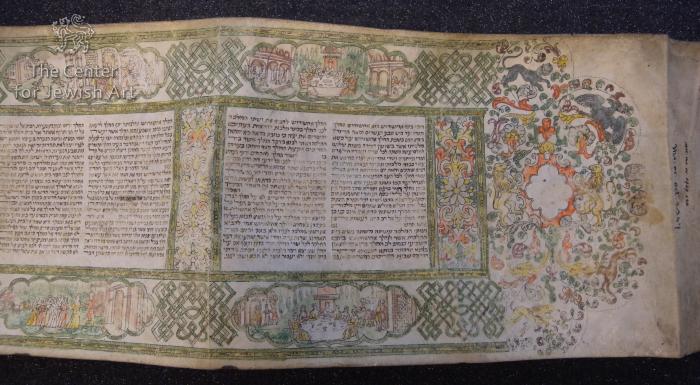Obj. ID: 34125
Hebrew Illuminated Manuscripts SBB Gaster I Type Esther Scroll, Venice (?), second half of the 17th century

This scroll represents the type called Gaster I (for explanation, see "Additional Remarks"), lavishly decorated megillot produced in a mixture of print and manuscript techniques: the decorative border is printed as a copper engraving and colored by hand, while the Hebrew text of the Book of Esther is penned by a scribe. The opening section is filled with a rich, precisely rendered, decoration of tendrils, flowers, and animals that surround a cartouche. The upper and lower margins are adorned with a pattern of repeating endless knot motifs alternating between 20 cartouches, each of which depicts between one and three scenes of the Book of Esther; In this scroll, the background behind them is left colorless. The ten text panels, in which nineteen text columns are included, are separated by stylized floral ornamentation. The same scheme repeats on all three sheets of this scroll. The pattern ends with a symmetrical decoration composed of large flowers and foliate ornaments surrounding a cartouche.
The name "Gaster I" was introduced by Mendel Metzger in his article entitled "The Earliest Engraved Italian Megilloth" (see "Bibliography"). The type was named after Moses Gaster (1856–1939), the rabbi, scholar, and manuscript collector, who owned a scroll adorned with this pattern (at present this is the scroll Gaster Hebrew MS 710 stored in the John Rylands Library in Manchester that is described here). At least 25 manuscripts representing this type are still extant and are preserved in private and institutional collections. For their descriptions see "Related objects".
In the article by Mendel Metzger (Eine illustrierte...), the manuscript is called a "Marburger" megillah due to its previous storage location.
The pattern features a number of decorative elements common with the scrolls of Klagsbald type.
The opening decoration lacks its far-right part that is not printed. Also in some other places on the first and third sheets, the border is not entirely printed.
The color scheme of this manuscript is more limited than in many other scrolls decorated with the same pattern.
sub-set tree:
| Ms. or. oct. 2947
The length of the sheets: 1) ca. 645 mm, 2) ca. 520 mm, 3) ca. 540 mm long (the third membrane could not be measured precisely because it could not be completely unrolled).
Dimensions of the selected details in the scrolls:
- inner dimensions of a typical text panel: ca. 100 x 78 mm;
- an average letter: 1-2 mm (height);
- letters in col. 16: 4 mm (height);
- the space between the subsequent lines of the text: 2 mm.
The scroll consists of 3 membranes with 19 columns (9 double text panels and one single panel) with 22 lines, except for col. 16 written in 11 lines divided into two parts. The membranes contain respectively 6, 8, and 5 text columns.
The text is written on the flesh side of parchment membranes in a small, square Italian script, in black ink. The handwriting of the second sheet is slightly different than the script on the first and the third sheets. The same is true as to the shade of the ink.
The letters ח and ת (respectively Es. 1:6 and Es. 9:29) are enlarged and bolded. Enlarged and diminished letters are also included in col. 16.
The ruling was made by a stylus and consists of 22 horizontal lines ruled across the width of the sheet but currently, they are only slightly visible; better visible are vertical lines (1+2+1 in the text panel).
The pricking can be discerned in some places.
The membranes in the scroll are stitched together.
Until 1970, this was in the collection of the Westdeutsche Bibliothek in Marburg (former Preussische Staatsbibliothek). Before the opening decoration, there is a blank fragment of parchment (ca. 120 mm wide) that contains two numbers written in black ink: "acc[?]. ms. or. 1929.130" and "Ms. or. oct. 2947", and a red stamp. Exhibited at the "Synagoga" exhibition in 1960/1961 in Recklinghausen and again in 1961 in Frankfurt am Main (respectively objects B 64 and 124 in the catalogues - see "Bibliography").
The scroll is mentioned in:
Ernst Róth, Hans Striedel. Wiesbaden: Steiner, 1965-1984. Hebräische Handschriften, 135.
Mendel Metzger, Eine illustrierte Estherrolle der zweiten Hälfte des 18. Jahrhunderts im Historischen Museum Frankfurt am Main, mit einem Anhang über Megilla-Hülsen, „Schriften des Historischen Museums Frankfurt am Main” 1972, no. 13, 95–116.
Synagoga. Kultgeräte und Kunstwerke von der Zeit der Patriarchen bis zur Gegenwart, Städtische Kunsthalle Recklinghausen, 3. November 1960 – 15. Januar 1961, ed. Anneliese Schröder, Recklinghausen 1961, object B 64.
Synagoga. Jüdische Altertümer Handschriften und Kultgeräte. Historisches Museum Frankfurt am Main, 17. Mai – 16. Juli 1961, Frankfurt am Main 1961, object 124.
Kitwe-jad - Jüdische Handschriften : restaurieren - bewahren - präsentieren; [Ausstellung der Staatsbibliothek zu Berlin - Preußischer Kulturbesitz, 4. Juli 2002 - 17. August 2002] / [Gesamtgestaltung: Stephan Rosenthal] Teil 1: Jüdische Kultur im Spiegel der Berliner Sammlung / [Ausstellung und Katalog: Petra Werner]. Berlin, 2002. 198 S. : zahlr. Ill. [Kat. Nr. 12]
A short description in German and English and digital images available on http://resolver.staatsbibliothek-berlin.de/SBB0001BF8000000001 (accessed on 23.05.2020).
Selected bibliography concerning other scrolls decorated with the same border:
Mendel Metzger, The Earliest Engraved Italian Megilloth, Bulletin of the John Rylands Library 1966, 48/2, 381–432.
Cornelia Bodea, Treasures of Jewish Art. The 1673 Illuminated Scroll of Esther Offered to a Romanian Hierarch, Iaşi–Oxford–Palm Beach–Portland 2002.
A Journey through Jewish Worlds: Highlights from the Braginsky Collection of Hebrew Manuscripts and Printed Books, eds. Evelyn M. Cohen, Emile Schrijver, Sharon Liberman Mintz, Amsterdam 2009, 240-241.
Schöne Seiten. Jüdische Schriftkultur aus der Braginsky Collection, eds. Emile Schrijver, Falk Wiesemann, Evelyn M. Cohen, Sharon Liberman Mintz, Menahem Schmeltzer, Zurich 2011, 262-263.
Dagmara Budzioch, The Decorated Esther Scrolls from the Museum of the Jewish Historical Institute in Warsaw and the Tradition of Megillot Esther Decoration in the Seventeenth and Eighteenth Centuries – An Outline [Polish: Dekorowane zwoje Estery z Żydowskiego Instytutu Historycznego w Warszawie na tle tradycji dekorowania megilot Ester w XVII i XVIII wieku. Zarys problematyki], Warsaw 2019, 1:99-119, 2:64-69.
Dagmara Budzioch, "An Illustrated Scroll of Esther from the Collection of the Jewish Historical Institute as an Example of the Gaster I Megilloth," Kwartalnik Historii Żydów 2013, no. 3 (247), 533–547.






